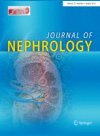The need for clinical, genetic and radiological characterization of atypical polycystic kidney disease
Abstract
Background
Autosomal Dominant Polycystic Kidney Disease (ADPKD) is a monogenic disease having a prevalence of 1:400–1000 live births. Depending on kidney imaging, patients can be subdivided into Class 1 (typical) and Class 2 (atypical). The present study aims to provide better assessment of Class 2 patients to help define their family history, together with their clinical and radiological characteristics.
Methods
One hundred twenty-four PKD patients with abdominal Magnetic Resonance Imaging (MRI) for the staging of ADPKD, were retrospectively analyzed, aiming to focus on Class 2 ADPKD patients. Total kidney volume and total cyst volume were evaluated, while also assessing their clinical and genetic characteristics.
Results
Twelve patients fulfilled the Mayo criteria for Class 2 ADPKD (two Class 2B and ten Class 2A). Extrarenal involvement was observed in 66.7% of cases, but only two subjects presented an estimated Glomerular Filtration Rate (eGFR) < 60 mL/min/1.73 m2. A positive family history for cystic disease was more frequent compared to other published cohorts. Only 8.3% tested positive for a likely pathogenic mutation in the PKD1 gene. Class 2B patients showed a lower height-adjusted total kidney volume, with a lower percentage of total cyst volume.
Conclusion
Based on our results, atypical ADPKD does not represent an uncommon condition, being present in about 10% of MRI-evaluated patients diagnosed with ADPKD. Genetic tests are frequently negative for PKD1/PKD2, and total cyst volume and residual tissue volume do not increase the prognostic value of MRI in patients with these radiological characteristics. Other tools are needed to better characterize their kidney prognosis.
Graphical abstract




